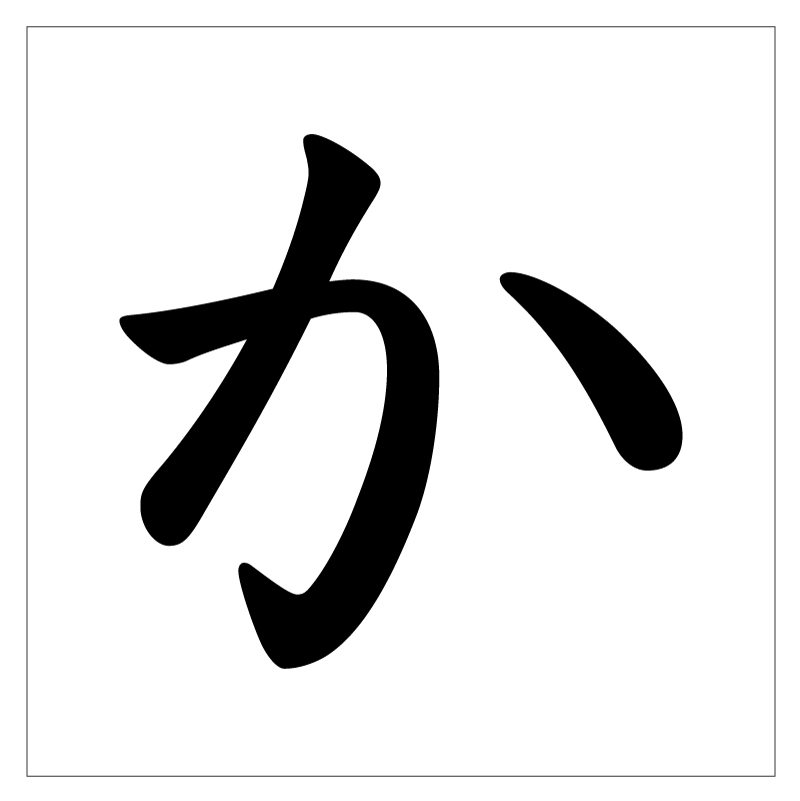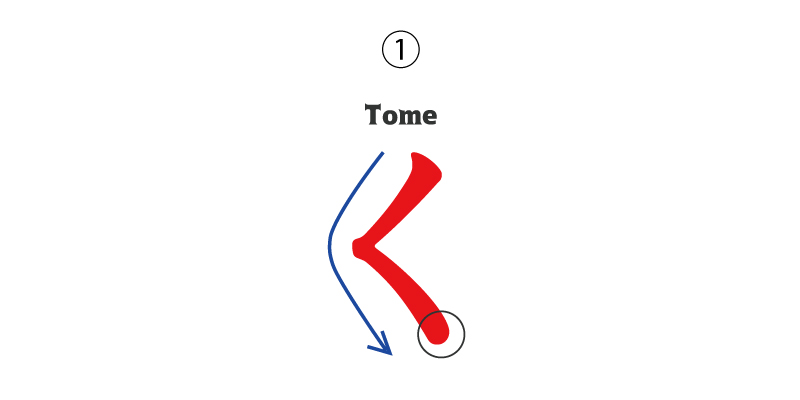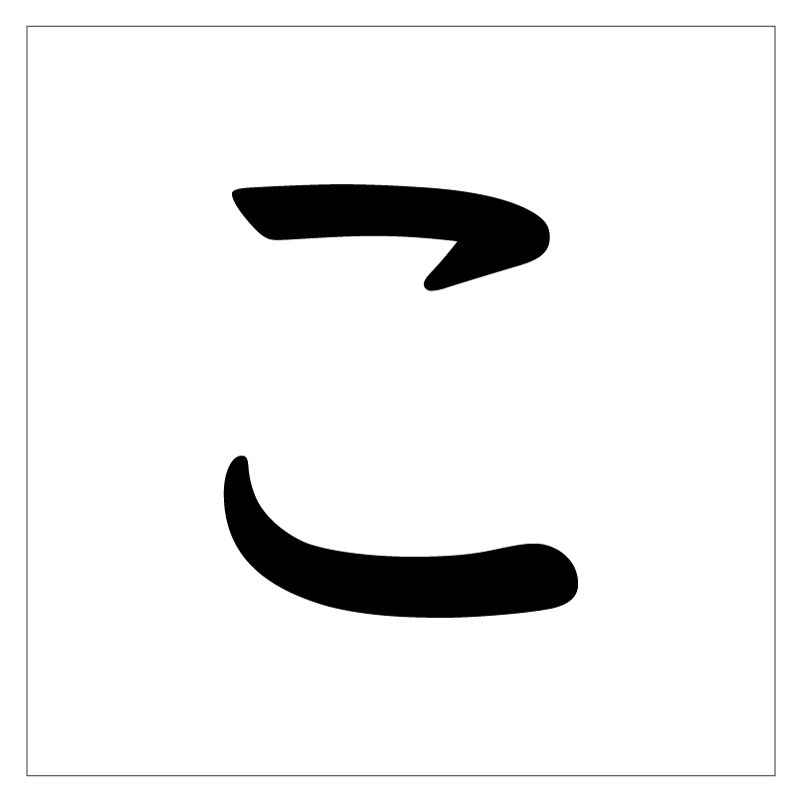

Say ‘Ko n ni chi wa’! It’s Time to Learn ‘Ka Ki Ku Ke Ko’.
2018-11-05T11:59:42
Now you can read and write ‘あ い う え お’. (to read more about ‘あいうえお’ here.) Then, the next thing that you have to learn should be ‘か き く け こ’. Simply put ‘K’ on the vowels ‘a i u e o’. You can learn how to write ‘かきくけこ’ in Hiragana here. (You can learn about Hiragana here.) Let’s practice a lot and use ‘かきくけこ’ everyday!
How to read and write ‘か’
‘か’ is pronounced as /ka/. It can be written in three strokes. ①Hane, ②Tome, and ③Tome. (Read about Hane, Tome and Harai here.)
Now Let’s Use ‘か’!
かわいい [ka wa i i]
Say ‘かわいい [ka wa i i]’ if you see something or someone lovely or adorable like a puppy or a baby.
かっこいい [ka kko i i] ↔︎ かっこわるい [ka kok wa ru i]
‘かっこいい [ka kko i i]’ means good looking, handsome, cool. And you can use ‘かっこいい’ when you describe someone or something like a man or a sports car. ‘かっこいい’ is usually used when describing masculine gender.
The antonym is ‘かっこわるい [ka kko wa ru i]’ . Note that ’いい [i i](よい [yo i])’ means good and ‘わるい [wa ru i]’ means bad.
かしこい [ka shi ko i]
‘かしこい’ means smart or clever.
For example:
‘This dog is very “かしこい”. He can understand what I say.’
‘Schyla is “かしこい” because she can write and speak Japanese language at three years old.’
かたい [ka ta i]
You can use ‘かたい [ka ta i]’ when you describe something hard or difficult. For example, you find it hard to open a cap in a bottle or turn on the faucet. Another instance to use ‘かたい’ is when you describe something that is hard like a concrete wall or a stone.
からい [ka ra i]
When you eat something very hot, spicy, and salty then the spices and salt get into your nerve that it’s unbearable to the point of causing you to have runny nose, say ‘からい [ka ra i]’.
かゆい [ka yu i]
‘かゆい [ka yu i]’ means itchy. For example, you are bitten by a mosquito that you feel itchy, you can say ‘かゆい’.
かしこまりました [ka shi ko ma ri ma shi ta]
‘かしこまりました [ka shi ko ma ri ma shi ta]’ is a polite way of expressing your agreement to do something toward someone like your boss and your clients.
かんぱい [ka n pa i]
Say ‘かんぱい [ka n pa i]’ as you hold your drinking glass and raise it toward each other making well wishes to someone in a party like weddings or birthdays. This is what you say when you toast in Japanese.
How to read and write ‘き’
‘き’ is pronounced as /ki/. It can be written in four strokes. ①Tome, ②Tome, ③Hane, and ④Tome.
Now Let’s Use ‘き’!
きをつけて [ki o tsu ke te]
‘きをつけて [ki o tsu ke te]’ means take good care. There are several instances to say ‘take good care’ to someone. For example, a person is about to go somewhere or do something say ‘きをつけて’. ‘きをつけて’ may also mean “be safe” like in the case of typhoon or other calamities.
きけん [ki ke n]
When you see something with the sign saying’きけん [ki ke n], don’t touch it because it is dangerous. ‘あぶない [a bu na i]’ also has the same meaning.
きれい [ki re i] ↔︎ きたない [ki ta na i]
‘きれい [ki re i]’ has two meanings –beautiful and clean.
Examples:
‘She is very beautiful (きれい).’
‘This room is so clean (きれい).’
On the other hand, ‘きたない’ [ki ta na i] means ugly, dirty or messy.
きもちいい [ki mo chi i i] ↔︎ きもちわるい [ki mo chi wa ru i]
Upon waking up in the morning and you are feeling good and feeling relaxed, you can say ‘きもちいい [ki mo chi i i]’. Also, you can say ‘きもちいい’ while or after you get a good massage. The antonym is ‘きもちわるい’ [ki mo chi wa ru i]. ‘きもい [ki mo i]’ is the informal form of きもちわるい.
For example:
‘きもちわるい。はきそう [ki mo chi wa ru i ha ki so u]。(I’m feeling bad so I want to vomit.)’
In this example, you can say this if you are feeling bad after drinking a lot of alcoholic drink such as beer.
‘きもい! ‘
It is usually said when someone feels bad against someone’s attitude or if someone doesn’t like something like a cockroach.
きらい [ki ra i]
If you don’t like someone or something, say ‘きらい [ki ra i]’.
きつい [ki tsu i]
‘きつい [ki tsu i]’ can mean a lot of things depending on what is being described.
Examples:
‘きつい’ generally means:
tight – ‘tight clothes’ or ‘tightly connected rope’
exhausting – ‘exhausting work’
intensive – ‘intensive training or exercise’
strong –‘strong drink’ or ‘strong alcoholic drink’
きのう [ki no u] (→ きょう [kyo u] → あした [a shi ta])
Yesterday is ‘きのう [ki no u] while today is ‘きょう [kyo u]’ and tomorrow is ‘あした [a shi ta]’.
How to read and write ‘く’
‘く’ is pronounced as /ku/. It can be written in one strokes, ends with Tome.
Now Let’s Use ‘く’!
くらい [ku ra i]
‘くらい [ku ra i]’ means dark.
For example:
Dark place (without light)― ‘きをつけて、when you are walking in a “くらい” road.’
Dark personality (negative attitude)― ‘Because of his dark(= “くらい”) personality, I don’t like(= “きらい”) him.’
くさい [ku sa i]
‘くさい [ku sa i]’ is a caution to avoid experiencing something bad like eating a stale food or getting burned in a fire. It means smelly.
くるしい [ku ru shi i]
“くるしい [ku ru shi i]” means a lot depending on the situation.
For example:
‘You are drowned and you feel “くるしい [ku ru shi i]” because you can’t breath well.’
‘You are inside a house in fire and you feel ‘くるしい [ku ru shi i]’ because of the smoke (you are suffocated.)’
How to read and write ‘け’
‘け’ is pronounced as /ke/. It can be written in three strokes. ①Hane, ②Tome, and ③Harai.
Now Let’s Use ‘け’!
けんこう [ke n ko u]
This is the most important thing in life. Money? No! ‘けんこう [ke n ko u]’ is health. Health is wealth.
けっこん [ke kko n]
‘けっこん [ke kko n]’ means marriage. You can say ‘けっこん、おめでとう [o me de to u]’, means Congratulations on your wedding!
けっこう [ke kko u]
‘けっこう [ke kko u]’ means a lot – nice, good, fine. Additionally, it means enough or no need, quite, so and too.
For example:
‘nice view (“けっこうなけしき [kekkou na keshiki]”).’
If the cashier offers you the receipt in the market and you don’t need one, you can say ‘けっこうです [kekkou desu] (No need, thank you.)’
‘This book is so interesting. (“このほん、けっこうおもしろいね。 [ko no ho n, ke kko u o mo shi ro i ne]”)’
How to read and write ‘こ’
‘こ’ is pronounced as /ko/. It can be written in two strokes. ①Hane, and ②Tome.
Now Let’s Use ‘こ’!
これ [ko re]/ この [ko no]
‘これ [ko re]’ and ‘この [ko no]’ are both pronoun ‘this’. ‘これ’ does not need any object while ‘この’ is always followed by an object.
For instance:
What is this (これ)?
What is this (この) smell?
ここ [ko ko] / こっち [ko cchi] / こちら [ko chi ra]
‘ここ [ko ko]’ means ‘here’ in English which can only be used to point to a certain place or a certain time.
‘こっち [ko cchi]’ means ‘here’ in English which can be used to emphasize a specific direction, place, thing, and person. Additionally, ‘こちら [ko chi ra]’ is the polite form of ‘こっち’. So, are you confused on what to use either ‘ここ’ or ‘こっち’ ? You don’t have to be confused because you can use either ‘ここ’ or ‘こっち’.
For example:
‘ここ’ – ‘Here is my home.’ (The speaker needs to point the home or the place being referred to.)
‘こっち’ – ‘Come here.’ (The speaker is telling the other party to come closer to him or her.)
こわい [ko wa i]
‘こわい [ko wa i]’ means scary or scared. What makes you feel ‘こわい’?
For example:
‘Horror movie is “こわい”.’
“I feel ‘こわい’ with roller coaster ride.”
こんにちは [ko n ni chi wa]
Say ‘こんにちは [ko n ni chi wa]’ when you see or visit someone at daytime. Note that ‘は’ is pronounced [wa] here because in this case, ‘は’ is used as a particle.
こんばんは [ko n ba n wa]
Say ‘こんばんは [ko n ba n wa]’ when you see or visit someone at night.
Let’s practice!
Look at the drawing on top of this article. A boy came to a book store to buy a book. Then the cashier of the bookstore(who looks like ‘かっぱ [ka ppa], a monster in Japan’) greeted him. See the conversation between the boy and the staff of the bookstore.
Staff: いらっしゃいませ。[i ra ssha i ma se] / こちらへどうぞ 。[ko chi ra e do u zo].
Boy: こんにちは。[ko n ni chi wa] / これ、ください。[ko re, ku da sa i]
When the cashier gave him the change with the receipt.
Boy: レシートはけっこうです。[re shi i to wa ke kko u de su] (I don’t need receipt.)
Staff: かしこまりました。[ka shi ko ma ri ma shi ta] / ありがとうございました。[A ri ga to u go za i ma shi ta] / またおこしください。[ma ta o ko shi ku da sa i]
きょうはここまで!(That’s all for today!) おつかれさまでした!











